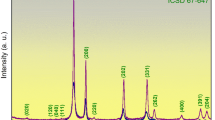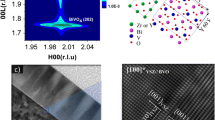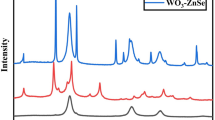Abstract
A series of self-assembled WO3–BiVO4 nanostructured thin films with 17, 25, 50, 67, and 100 mol% WO3 were grown on the (001) yttria-stabilized zirconia (YSZ) substrate by pulsed laser deposition method. The microstructures including crystalline phases, epitaxial relationship, interface structures, and chemical composition distributions were investigated by a combination of various electron microscopy techniques including scanning electron microscopy, transmission electron microscopy, and X-ray energy dispersive spectroscopy. The monoclinic BiVO4 formed the matrix, in which WO3 nanopillars were embedded with specific epitaxial relationships. In BiVO4-rich sample, orthorhombic Bi2WO6 was formed. However, metastable hexagonal WO3 phase and orthorhombic WO3 phase coexisted in other composite samples. The thin amorphous layer at the film/substrate interface indicated that the mismatch strain between films and substrate is released. The hydrostatic tensile strain due to thermal expansion mismatch between BiVO4 and WO3 as well as the diffusion of Bi into the WO3 stabilized the metastable h-WO3. A WO3–BiVO4 pseudobinary phase diagram was proposed based on the magnitude of the thermal expansion mismatch and the distance of Bi diffusion, which can be applied to design the microstructures of WO3–BiVO4 heterojunctions and optimize their photoelectrochemical properties.







Similar content being viewed by others
References
A. Fujishima and K. Honda: Electrochemical photolysis of water at a semiconductor electrode. Nature 238, 37–38 (1972).
M.G. Walter, E.L. Warren, J.R. McKone, S.W. Boettcher, Q. Mi, E.A. Santori, and N.S. Lewis: Solar water splitting cells. Chem. Rev. 110, 6446–6473 (2010).
K. Maedaa: Photocatalytic water splitting using semiconductor particles: History an recent developments. J. Photochem. Photobiol., C 12, 237–268 (2011).
R. Chatten, A.V. Chadwick, A. Rougier, and P.J.D. Lindan: The oxygen vacancy in crystal phases of WO3. J. Phys. Chem. B 109, 3146–3156 (2005).
J.K. Cooper, S. Gul, F.M. Toma, L. Chen, P-A. Glans, J. Guo, J.W. Ager, J. Yano, and I.D. Sharp: Electronic structure of monoclinic BiVO4. Chem. Mater. 26, 5365–5373 (2014).
S.J. Hong, S. Lee, J.S. Jang, and J.S. Lee: Heterojunction BiVO4/WO3 electrodes for enhanced photoactivity of water oxidation. Energy Environ. Sci. 4, 1781 (2011).
K. Zhang, X.J. Shi, J.K. Kim, and J.H. Park: Photoelectrochemical cells with tungsten trioxide/Mo-doped BiVO4 bilayers. Phys. Chem. Chem. Phys. 14, 11119–11124 (2012).
J. Su, L. Guo, N. Bao, and C.A. Grimes: Nanostructured WO3/BiVO4 heterojunction films for efficient photoelectrochemical water splitting. Nano Lett. 11, 1928–1933 (2011).
Y. Park, K.J. McDonald, and K.S. Choi: Progress in bismuth vanadate photoanodes for use in solar water oxidation. Chem. Soc. Rev. 42, 2321–2337 (2013).
F.F. Abdi, T.J. Savenije, M.M. May, B. Dam, and R. van de Krol: The origin of slow carrier transport in BiVO4 thin film photoanodes: A time-resolved microwave conductivity study. J. Phys. Chem. Lett. 4, 2752–2757 (2013).
Y. Pihosh, I. Turkevych, K. Mawatari, T. Asai, T. Hisatomi, J. Uemura, M. Tosa, K. Shimamura, J. Kubota, K. Domen, and T. Kitamori: Nanostructured WO3/BiVO4 photoanodes for efficient photoelectrochemical water splitting. Small 10, 3692–3699 (2014).
P.M. Rao, L. Cai, C. Liu, I.S. Cho, C.H. Lee, J.M. Weisse, P. Yang, and X. Zheng: Simultaneously efficient light absorption and charge separation in WO3/BiVO4 core/shell nanowire photoanode for photoelectrochemical water oxidation. Nano Lett. 14, 1099–1105 (2014).
X. Shi, I.Y. Choi, K. Zhang, J. Kwon, D.Y. Kim, J.K. Lee, S.H. Oh, J.K. Kim, and J.H. Park: Efficient photoelectrochemical hydrogen production from bismuth vanadate-decorated tungsten trioxide helix nanostructures. Nat. Commun. 5, 4775 (2014).
Y. Pihosh, I. Turkevych, K. Mawatari, J. Uemura, Y. Kazoe, S. Kosar, K. Makita, T. Sugaya, T. Matsui, D. Fujita, M. Tosa, M. Kondo, and T. Kitamori: Photocatalytic generation of hydrogen by core–shell WO3/BiVO4 nanorods with ultimate water splitting efficiency. Sci. Rep. 5, 11141 (2015).
C.N. Van, T.H. Do, J-W. Chen, W-Y. Tzeng, K-A. Tsai, H. Song, H-J. Liu, Y.C. Lin, Y-C. Chen, C-L. Wu, C-W. Luo, W.C. Chou, R. Huang, Y-J. Hsu, and Y-H. Chu: WO3 mesocrystal-assisted photoelectrochemical activity of BiVO4. NPG Asia Mater. 9, e357 (2016).
O. Lebedev, J. Verbeeck, G. Van Tendeloo, O. Shapoval, A. Belenchuk, V. Moshnyaga, B. Damashcke, and K. Samwer: Structural phase transitions and stress accommodation in (La0.67Ca0.33MnO3)1−x:(MgO)x composite films. Phys. Rev. B 66, 104421 (2002).
H. Zheng, J. Wang, S.E. Lofland, Z. Ma, L. Mohaddes-Ardabili, T. Zhao, L. Salamanca-Riba, S.R. Shinde, S.B. Ogale, F. Bai, D. Viehland, Y. Jia, D.G. Schlom, M. Wuttig, A. Roytburd, and R. Ramesh: Multiferroic BaTiO3–CoFe2O4 nanostructures. Science 303, 661–663 (2004).
H. Luo, H. Yang, S.A. Baily, O. Ugurlu, M. Jain, M.E. Hawley, T.M. McCleskey, A.K. Burrell, E. Bauer, L. Civale, T.G. Holesinger, and Q. Jia: Self-assembled epitaxial multiferroic nanocomposite films prepared by polymer-assisted deposition. J. Am. Chem. Soc. 129, 14132–14133 (2007).
J.L. MacManus-Driscoll, P. Zerrer, H. Wang, H. Yang, J. Yoon, A. Fouchet, R. Yu, M.G. Blamire, and Q. Jia: Strain control and spontaneous phase ordering in vertical nanocomposite heteroepitaxial thin films. Nat. Mater. 7, 314–320 (2008).
A. Chen, Z. Bi, Q. Jia, J.L. MacManus-Driscoll, and H. Wang: Microstructure, vertical strain control and tunable functionalities in self-assembled, vertically aligned nanocomposite thin films. Acta Mater. 61, 2783–2792 (2013).
J.L. MacManus-Driscoll: Self-assembled heteroepitaxial oxide nanocomposite thin film structures: Designing interface-induced functionality in electronic materials. Adv. Funct. Mater. 20, 2035–2045 (2010).
W.L. Winterbottom: Equilibrium shape of a small particle in contact with a foreign substrate. Acta Metall. 15, 303–310 (1967).
H. Zheng, F. Straub, Q. Zhan, P-L. Yang, W-K. Hsieh, F. Zavaliche, Y-H. Chu, U. Dahmen, and R. Ramesh: Self-assembled growth of BiFeO3–CoFe2O4 nanostructures. Adv. Mater. 18, 2747–2752 (2006).
H.J. Liu, W.I. Liang, Y.H. Chu, H.M. Zheng, and R. Ramesh: Self-assembled vertical heteroepitaxial nanostructures: From growth to functionalities. MRS Commun. 4, 31–44 (2014).
W. Zhang, A. Chen, Z. Bi, Q. Jia, J.L. MacManus-Driscoll, and H. Wang: Interfacial coupling in heteroepitaxial vertically aligned nanocomposite thin films: From lateral to vertical control. Curr. Opin. Solid State Mater. Sci. 18, 6–18 (2014).
P. Shuk, H-D. Wiemhofer, U. Guth, W. Gopel, and M. Greenblatt: Oxide ion conducting solid electrolytes based on Bi2O3. Solid State Ionics 89, 179–196 (1996).
M. Drache, P. Roussel, and J-P. Wignacour: Structures and oxide mobility in Bi–Ln–O materials: Heritage of Bi2O3. Chem. Rev. 107, 80–96 (2006).
S.P. Berglund, A.J. Rettie, S. Hoang, and C.B. Mullins: Incorporation of Mo and W into nanostructured BiVO4 films for efficient photoelectrochemical water oxidation. Phys. Chem. Chem. Phys. 14, 7065–7075 (2012).
W. Luo, J. Wang, X. Zhao, Z. Zhao, Z. Li, and Z. Zou: Formation energy and photoelectrochemical properties of BiVO4 after doping at Bi3+ or V5+ sites with higher valence metal ions. Phys. Chem. Chem. Phys. 15, 1006–1013 (2013).
C. Rosen, E. Banks, and B. Post: The thermal expansion and phase transitions of WO3. Acta Crystallogr. 9, 475–476 (1955).
A. Waskowska, A. Pietraszko, and K. Lukaszewicz: BiVO4: X-ray diffraction study of the thermal expansion. Ferroelectrics 79, 131–134 (1988).
H. Zheng, J.Z. Ou, M.S. Strano, R.B. Kaner, A. Mitchell, and K. Kalantar-zadeh: Nanostructured tungsten oxide—Properties, synthesis, and application. Adv. Funct. Mater. 21, 2175–2196 (2011).
Z.F. Huang, J. Song, L. Pan, X. Zhang, L. Wang, and J.J. Zou: Tungsten oxides for photocatalysis, electrochemistry, and phototherapy. Adv. Mater. 27, 5309–5327 (2015).
B. Gerand, G. Nowogrocki, J. Guenot, and M. Figlarz: Structural study of a new hexagonal form of tungsten trioxide. J. Solid State Chem. 29, 429–434 (1979).
H. Kalhori, S.B. Porter, A.S. Esmaeily, M. Coey, M. Ranjbar, and H. Salamati: Morphology and structural studies of WO3 films deposited on SrTiO3 by pulsed laser deposition. Appl. Surf. Sci. 390, 43–49 (2016).
C.V. Ramana, S. Utsunomiya, R.C. Ewing, C.M. Julien, and U. Becker: Structural stability and phase transitions in WO3 thin films. J. Phys. Chem. B 110, 10430–10435 (2006).
I.M. Szilágyi, J. Madarász, G. Pokol, P. Király, G. Tárkányi, S. Saukko, J. Mizsei, A.L. Tóth, A. Szabó, and K. Varga-Josepovits: Stability and controlled composition of hexagonal WO3. Chem. Mater. 20, 4116–4125 (2008).
P. Ju, P. Wang, B. Li, H. Fan, S. Ai, D. Zhang, and Y. Wang: A novel calcined Bi2WO6/BiVO4 heterojunction photocatalyst with highly enhanced photocatalytic activity. Chem. Eng. J. 236, 430–437 (2014).
M-S. Gui, W-D. Zhang, Y-Q. Chang, and Y-X. Yu: One-step hydrothermal preparation strategy for nanostructured WO3/Bi2WO6 heterojunction with high visible light photocatalytic activity. Chem. Eng. J. 197, 283–288 (2012).
ACKNOWLEDGMENTS
This work was supported by the National Key Project for Basic Research of China (Grant Nos. 2014CB921104 and 2013CB922301), NSFC under Grant No. 51572085, and Natural Science Foundation of Shanghai (16ZR1409500).
Author information
Authors and Affiliations
Corresponding author
Rights and permissions
About this article
Cite this article
Song, H., Li, C., Van, C.N. et al. Microstructure evolution with composition ratio in self-assembled WO3–BiVO4 hetero nanostructures for water splitting. Journal of Materials Research 32, 2790–2799 (2017). https://doi.org/10.1557/jmr.2017.250
Received:
Accepted:
Published:
Issue Date:
DOI: https://doi.org/10.1557/jmr.2017.250




